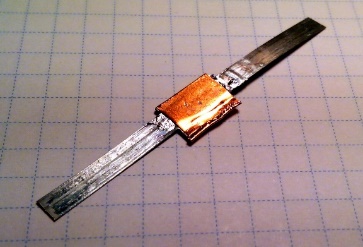(Retracted) Superconducting Solder Joint for Rare Earth Oxide Superconducting Wires
—The New Technique May Expedite the Development of Powerful Electromagnets Operated in Persistent Current Mode—
2018.05.23
National Institute for Materials Science (NIMS)
Japan Science and Technology Agency (JST)
Abstract
- A NIMS research team succeeded for the first time in jointing rare earth oxide superconducting wires using superconducting solder and feeding the current through the joint, maintaining superconductivity. The new technique may expedite the development of powerful electromagnets using superconducting wires such as high resolution nuclear magnetic resonance (NMR) devices—vital instruments for the development of novel drugs—operated in persistent electric current mode.
- Electromagnets with superconducting wires are capable of generating very strong magnetic fields with a large electric current and no electrical resistance. These electromagnets have been used in NMR devices—vital instruments for the development of novel drugs—and other equipment. Jointing superconducting wires without losing the superconductivity between the wires enables us to keep an electric current almost perpetually without an external power source, which leads to reduce the energy consumption during the operation and resolve noise problems associated with the use of an external power source. Among various techniques used to joint superconductive materials, the joint technique using “superconductive solder” having a low melting point is the most convenient and widely-used method. Although the superconductive solder joint technique has been proven effective for almost all the potentially practical superconducting wires, the soldered superconducting joint of rare earth oxide superconducting wires has not yet been established.
- In this research project, we closely examined the early step of the superconducting solder process to replace a protective layer on the superconducting layer with a tin-based alloy, preventing exposure of the superconducting layer to the air: this initial step is done before replacement process of the coated tin-based alloy with a superconducting solder. We found that the tin-based alloy easily reacts with the rare earth oxide superconducting layer, severely damaging its superconductivity. In addition, we found that rapid replacement of the protective layer with the tin-based alloy results in a poor electrical connection. Based on these findings, we consequently optimized the replacement condition to achieve the best connections. We then applied a pressurized thermal treatment to the joint part where the two superconducting wires are set so that the superconducting layers are arranged face-to-face and lapped by a thin copper foil. Through this process, we succeeded for the first time in jointing rare earth oxide superconducting wires using superconducting solder (see the figure below) and feeding the current through the joint, maintaining superconductivity.
- The soldering technique we developed is expected to enable the superconducting joint of rare earth oxide superconducting wires to not only commonly used niobium-based superconducting wires but also all potentially practical types of superconducting wires via the superconducting solder joint with niobium-based superconducting wires. This achievement could accelerate the development of powerful electromagnets operated in a persistent current mode. Since the rare earth oxide superconducting wires have excellent superconducting characteristics in very high magnetic field, the developed joint technique for the wires enabling persistent current mode operation could be applicable to the development of compact high resolution NMR devices. That could revitalize the NMR market.
- This research project was carried out by a NIMS research team led by Nobuya Banno (Principal Researcher, Research Center for Functional Materials, NIMS). We plan to present this study at the conference of the Cryogenics and Superconductivity Society of Japan (May 28-30, 2018) and the Applied Superconductivity Conference (Oct. 28-Nov. 2, 2018, Seattle).
This research was carried out in conjunction with the research project entitled, “Practical application of super-high field NMRs and DC superconducting cables in railway systems through advances in high temperature superconducting wire connection technology” (Project Leader: Hideaki Maeda, JST Program Manager / Senior Visiting Scientist, SPring-8 Center, RIKEN) funded by the JST-Mirai Program.

Figure used in the press release. Two rare earth-based superconducting wires jointed together using a superconducting solder
Contacts
-
Public Relations Office
National Institute for Materials Science
1-2-1 Sengen, Tsukuba, Ibaraki 305-0047, Japan
Tel: +81-29-859-2026
Fax: +81-29-859-2017
E-Mail: pressrelease=ml.nims.go.jp
(Please change "=" to "@")
Recent Press Release
-
Simultaneous Imaging of Intracellular DNA and RNA Using Harmless Light
2025.10.27
-
Development of an AI Device Using Ion Gel and Graphene That Dramatically Streamlines Machine Learning Computations
2025.10.14
-
Demonstrating a Novel Method to Modulate Heat Flow Through the Collective Motion of Spins
2025.10.06
